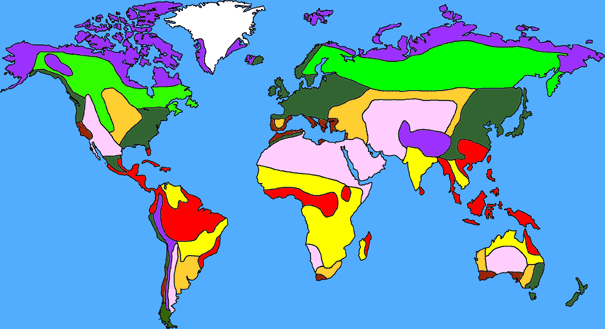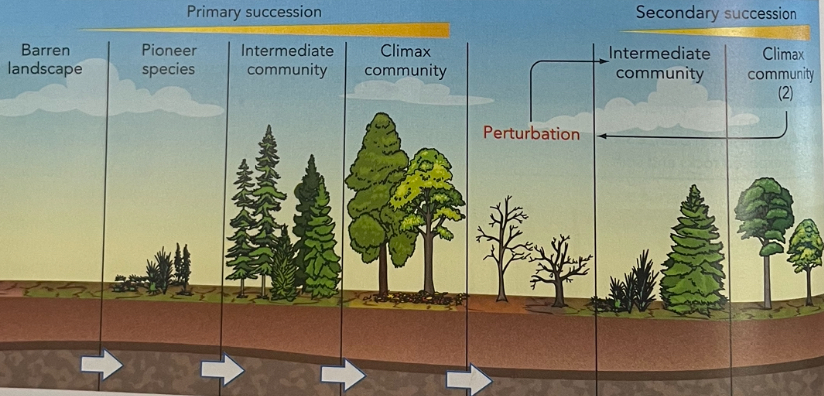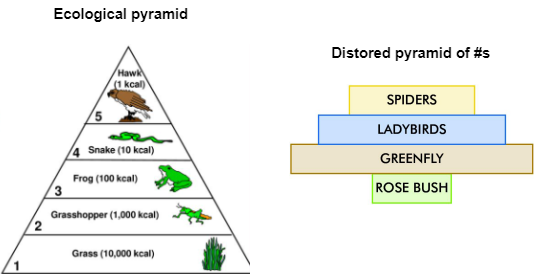Unit 4 - Managing ecosystems and biodiversity
4.1 Ecosystems

 Biomes: a form of ecosystems that are smaller than the biosphere
Biomes: a form of ecosystems that are smaller than the biosphere
Hot deserts (Middle of continents + western coasts; 14% of Earth’s surface):
High daytime & low nighttime temperature; generally light winds
>250mm of rainfall annually; high evaporation rates
Light colored soil that’s dry & sandy; top layer may be absent/very thin due to lack of vegetation
Cacti have drought tolerant seeds with waxy cuticles to prevent water from escaping
Human impact: mining, removal of rare species, & use of groundwater + drying out surface water
Tropical Rainforest (Equatorial zones of Asia + Central America & Asia):
Temperatures range from 22-31°C; low diurnal temperature (difference b/t high and low temperature in the same day)
2000mm of rainfall per year w/ high humidity levels; daily convectional rainfall
Red/yellow soil; high rainfall = nutrients + clays being leached out & replaced with aluminium oxide (high rate of decomposition)
Tall + thin trees allow for light, thin bark eliminates the need to conserve water, & leaves have a waxy surface with drip tips to allow excess water to runoff + prevent algae
Helps support high biodiversity
Human impact: deforestation, mining, urbanization, agriculture, & desertification
Grassland (Middle of continents - away from coasts):
Temperatures range from 20-35°C
Up to 750mm of rainfall annually w/ wet summer; unpredictable rainfall
Distinct dry & wet seasons
Red soil (high iron), highly weathered + porous allows for rapid drainage & thin layer on surface decays rapidly due to high temperatures
Soils aren’t very fertile; limited vegetation
Vegetation: grasses & umbrella shaped trees
Trees are spread apart & root systems are either widespread (to absorb water) or deep (reach groundwater during dry season)
Human impact: grazing, urbanization, & less biodiversity due to loss of habitat + hunting
Tundra (North Asia + S. America & S. coast of Greenland):
Temperatures range from -34-12°C; strong polar winds
Less than 250mm of rain annually & short summers
Dark brown soil, permafrost (permanently frozen) sub layer, organic material at surface
Vegetation: small plants that grow close together & are low to the ground
Waxy hair to coat them from cold & wind, shallow root systems due to permafrost
Human impact: melting of permafrost (methane) & drilling for resources
Major abiotic factors of a biome: temperature & precipitation
Primary and secondary Succession
Ecological succession: process of an ecosystem changing & developing
Primary succession: uncolonized areas → soil isn’t capable of sustaining life
Pioneer species (lichens & mosses) will establish themselves on bare rock
Start formation of soils by breaking down the rock → grasses + shrubs can grow
e.g) new lava flow, newly formed sand dunes, & newly quarried rock face
takes longer than secondary
Secondary succession: colonized area that was disturbed or damaged (hasn’t eliminated all life/removed all nutrients)
Soil is present; pioneer species = small plants
e.g) where a mudslide occurred or trees have fallen
Intermediate community: change from the initial community, but the final stage hasn’t been reached
Climax community: final stage of succession; depends on climate
Can take a few days to hundreds of years
Species involved in succession are controlled by abiotic factors like geology & climate
 Primary productivity: the rate in which energy is converted into organic material by autotrophs
Primary productivity: the rate in which energy is converted into organic material by autotrophs
Gross primary productivity: total amount of biological productivity within ecosystem/biome
Energy production per unit area / units of time
Net primary productivity: amount of energy captured minus energy used for respiration
GPP - Respiration
Decreases as distance from the equator increases
Abiotic factors that affect productivity: CO2, water, sunlight
Ecosystem productivity: rate at which biomass is produced within an ecosystem
Ecological (trophic) pyramids
Compare communities within/between ecosystems by analyzing their trophic levels
Represents energy, number of individuals/biomass in each trophic level
Pyramid of energy shows feeding relationships of an ecosystem
Greatest amount of energy at the bottom → ~10% transfer of energy b/t levels
Energy loss as heat due to respiration & excretion
Normal pyramid of numbers: largest # of organism at the bottom
Producers at bottom & tertiary consumers at the top
Along with a pyramid of biomass can have an unusual/inverted shape
Number below can support upper trophic levels
 4.2 Managing the conservation of biodiversity
4.2 Managing the conservation of biodiversity
Native and invasive species
Native species: originated & developed in a specific region/ecosystem and adapted to living there
Indigenous: occurring naturally in a specific area; native to an ecosystem
Invasive species: outcompete other species in the area it has invaded → changes balance in the ecosystem it invades
Can be native (outcompete other organisms in the ecosystem) or non-native
Primarily spread through human activity & often spread rapidly
Degrade native ecosystems → harmful to human health + local economies
Loss of indigenous flora = reduced biodiversity
Invasive species of flora have different characteristics → decrease organisms dependent on native flora
Potential impacts of invasive species: grazing, competition, predation, & disease transmission
Environmental | Social |
|---|---|
Soil erosion | Loss of agricultural land |
Excessive water consumption | Reduced access to water |
Decreased biodiversity + habitat degradation | Damage to infrastructure + reduced tourism opportunities |
Benefits of conserving biodiversity
Food security: protects plants, animals, & genetic resources that support soil fertility, disease regulation, & pollination of crops
Economic growth + poverty reduction: many poor populations depend on natural areas for their livelihoods; forests provide timber, food, & water
Combating climate change: forested areas can reduce CO2 levels & coastal ecosystems can lessen the impact of storm surges
Medical resources: medicinal qualities in plants to treat illness
High genetic diversity: greater stability → species are able to adapt to various conditions (e.g. disease & climate change)
Cultural and recreational value: biodiversity reflects social values + local beliefs
e.g) a culture may use rivers for baptism
Methods of conserving biodiversity
Protection of species + biodiversity
Sustainable harvest: use of a resource that ensures its constant supply without harming future yields/causing irreversible damage to an ecosystem
Requires educational + legislative solutions
Optimal harvest (set % of resource is harvested) & systematic random sampling (set % of material harvested from a defined part of an ecosystem) are sustainable
CITES (int’l trade in endangered species): aims to ensure sustainable trade & protect endangered animals + species
Limitation: hasn’t stopped illegal trade of protected species & voluntary participation
IWC (Int’l Whaling Committee): manage & conserve whale species globally
Catch limits are still too high & lacks punishment for those who don’t comply
EU CFP (Euro. Union Common Fisheries Policy): set rules for fishing fleets in EU waters
Limited applicability; West Africa is being overfished
ITTO (Int’l Tropical Timber Org.): encourage sustainable forest management + tropical timber harvest & trade
Large forest areas = hard to catch illegal harvesting
IUCN Red List: scientific info + tools to guide int’l actions in conservation
There may be species on the list that aren’t
EDGE: aims to protect species on the verge of extinction & have unique evolutionary history
EDGE Score: combined endangered conservation status + distinctiveness of species
Captive Breeding: breeding endangered species in captivity with the goal of releasing them back into protected wild areas in the future
Aims to develop a self-sustaining population of a species
Can lead to inbreeding w/ weak genetic traits → lower survival rates
Habitat conservation and creation
Rewilding: restoring an area of land to its natural uncultivated state
Reintroduced species + communities can thrive → biodiversity increases & ecosystem health improves
Extractive reserves: land where access & resource use rights are allocated to local groups or communities (e.g. managed sustainable extraction of natural resources)
Giving local communities rights → more inclined to protect resources
Protection of habitats: protects the whole habitat + each species benefits
Encourages species protection & biodiversity conservation
Nature reserves: legally protected area that is of importance for organisms or geology
Conservation, protecting natural resources, & scientific research
National parks: protects landscapes, wildlife, & natural features of large areas that are of conservational, education, or scientific interest
Protected by national laws
Marine conservation zones: nat’l/int’l importance with rare or threatened species + habitats that require protection
Typically don’t have a fishing ban, but have “no-take” zones (prohibits destroy natural resources)
MCZs form a greater network of protected zones
4.3 Impacts of human activity on ecosystems
Human impacts on tropical rainforests
Deforestation: causes fragmentation + lost of tropical forests
Plants + animals in the fragmentation ecosystem remain vulnerable (those that do survive cause a rapid decline in biodiversity)
Loss of genetic material + biodiversity
Exploration for + mining of minerals → forests being made into roads + infrastructure
Mining can lead to water, air, soil, noise, & light pollution
Agriculture: depletes the soil of nutrients due to soil erosion
Soils are thin + lack nutrients → due to leaching & heavy rainfall
Nutrients = stored in biomass
Completely deforested areas → soils collapse + high soil erosion
Contributes to climate change → forests store a lot of carbon (e.g. in photosynthesis)
Sustainable management of tropical rainforests
Preserve rainforests to: maintain biodiversity, protect the production of resources, manage climate change, & manage local water quality
Debt reduction: many tropical rainforests are found in LICs that have high levels of debt
Instead of remove rainforests to generate income → some HICs agreed to write off debt
In return, HIC asks for the protection of an area of the rainforest
Int’l agreements: manage species + forested areas through sustainable harvesting(e.g. CITES)
Need to include: educating those exploiting resources & providing consequences to negative action(s)
Legislation + protected areas: establishment of anti-deforestation public policies + private measures can significantly protect forested areas, biodiversity, + forest’s ability to absorb CO2
Needs to be rolled out across countries w/ large areas of tropical rainforests
Human impact on Antarctica
Climate change: warming oceans → loss of ice
Ocean acidification (from excess CO2) has caused a loss of biodiversity
Fishing: overfishing leads to the loss of krill, which can lead to the collapse of food chains
Tourism: increases potential of oil + sewage spillage (overall pollution)
Can disturb colonies of Antarctic animals
No individual gov’t has the power to set regulations
Ozone depletion: CFCs → hole in the ozone layer in the stratosphere above Antarctica
Strong and frequent winds + storms
Scientific research: helps understanding the continent + environment processes there
Can raise global awareness + used in formation of int’l laws
Research stations have a negative environmental impact
Strategies for managing the impacts of humans on Antarctica
Legislation & int’l agreement (e.g. The Antarctic Treaty):
Features like: banning the mining of minerals, cooperation b/t countries in scientific investigation, & no nuclear testing/disposal of nuclear waste
Prohibits the import of non-native flora & fauna species w/o a permit
Protected areas are continually set up
Tourism control through agreements like the IAATO
Stricter agreements are being put into place (e.g. requiring a tour operator to have a permit)
Educate tourists, reduce noise & light pollution, waste management policies